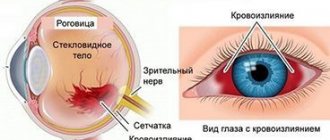A person receives up to 90% of information about the world around him through the organ of vision. The eye is a very sensitive organ; the eyes need to be protected and treated with attention to injuries and damage. Bleeding in the eye can occur at any age and for a variety of reasons. When is this a sign of pathology, and when can you do without a doctor? Why do complications develop, and can this be avoided?
First of all, hemorrhage is not a separate disease, but a symptom, sometimes indicating the presence of vascular or visual analyzer disease. If the pathology occurs against the background of injury or physical activity and is not accompanied by severe pain or visual impairment, then this situation is usually not dangerous. If additional symptoms are observed and the hemorrhage does not go away, you cannot do without the help of an ophthalmologist. Treatment depends solely on the cause of the problem and is prescribed only after examination.
Causes of red blood vessels in the eyes
There are many reasons that cause red eyes. These include various inflammations, infections, and excessive visual stress. The eyes turn red when wearing contact lenses if you do not follow the rules of disinfection, the regimen and timing of their wearing. The vessels may become visible if dry eye syndrome develops - with such an ophthalmological problem, a lack of tear fluid is detected, which negatively affects the condition of the capillaries.
Why eyes turn red - reasons:
- colds that occur with fever;
- dry eye syndrome when wearing contact lenses;
- increased visual stress;
- ophthalmological infectious diseases;
- allergic rhinitis, conjunctivitis;
- hypertension - due to increased pressure, blood vessels increase in volume;
- intraocular pressure, glaucoma;
- reaction to the use of medications;
- foreign body, dust, sand getting into the eye;
- hemorrhage as a result of blockage of the retinal veins, its detachment.
Reducing the amount of moisture in the eyes can cause the spread of viruses and infections, and inflammation of the conjunctiva. A healthy person has all the mechanisms to protect against such exposure. Tears contain lysozyme, a protein that has antimicrobial and antiviral effects. If there is little tear fluid, for example, due to working in rooms with functioning climate control equipment, or with increased visual stress at the computer, this can lead to redness of the eyes.
You can eliminate visible eye vessels with the help of whitening drops, which relieve redness and swelling of the conjunctiva, having a vasoconstrictor effect. But the problem will arise again if you ignore the very cause of red eyes.
And this reason may not be harmless at all, because some diseases of the visual organs require serious treatment due to the rapid development of dangerous symptoms. Thus, constantly increased intraocular pressure in glaucoma triggers irreversible processes. The earlier the disease is diagnosed, the better the prognosis.
Factors that cause red eyes
Redness of the whites of the eyes is a common problem, and this makes it seem insignificant. Many people notice that red streaks appear on the whites after a sleepless night, excessive consumption of strong alcoholic beverages, as a result of visual fatigue, and prefer to do nothing to eliminate such symptoms. Meanwhile, alcohol dilates blood vessels, increases blood flow, and then the vessels narrow again and the outflow of blood becomes more difficult, so the capillaries become overfilled with blood, which negatively affects the condition of their walls. The same processes occur when smoking in an unventilated room: blood vessels narrow, blood flow decreases, and dryness appears.
Negative factors affecting the condition of the blood vessels of the eyes:
- external irritants: tobacco smoke, smog, dust, windy weather;
- lack of sleep, bad habits;
- low-quality cosmetics, aerosols (irritation is caused by preservatives, lanolin, zinc oxide, titanium dioxide);
- washing, water procedures using chlorinated water - chlorine disrupts the microflora of the conjunctiva and lacrimal ducts;
- wearing contact lenses with low oxygen permeability parameters - such products prevent the passage of oxygen to the cornea, which affects the health of the visual organs.
To understand why the eyes turn red, you need to know what capillary damage is. The blood vessels do not burst, although many people think so when they see large red islands on the whites of the eyes. Simply due to the dilation of blood vessels, the blood in them becomes visible due to the fact that the walls of the capillaries themselves become thinner. Also, the vessels turn red due to the spread of infection, for example, with viral or bacterial conjunctivitis.
In this case, the fight against redness will be carried out in combination with therapeutic measures aimed at relieving inflammation and eliminating microbes and viruses.
Venous system of the eye
The venous system ensures the outflow of blood from the eye tissues. Its main link, the central retinal vein, is occupied by the outflow of blood from the structures supplied by the artery of the same name. It then joins the superior ophthalmic vein at the cavernous sinus.
The vorticose veins are involved in draining blood from the choroid. Four of them drain blood from the same area of the eye, then the two upper veins merge with the superior ophthalmic vein, and the two lower ones - with the lower one.
In all other respects, the venous outflow of the organs of the orbit and eye repeats the arterial blood supply, occurring in the reverse order. The bulk of the veins flow into the leaving orbit through the superior orbital fissure, the superior ophthalmic vein, the rest flow into the inferior ophthalmic vein, which usually has two branches. One of them is connected to the superior ophthalmic vein, the path of the second lies through the inferior orbital fissure.
The peculiarity of venous outflow is the absence of valves in the veins and a fairly close connection between the venous systems of the eyes, face, and brain, which poses a serious danger to life if purulent inflammation occurs.
How to remove red blood vessels in the eyes?
You can remove visible red blood vessels in the eyes, if the redness is not associated with colds and ophthalmological diseases, by using anti-inflammatory eye drops. If your eyes are red due to bacterial conjunctivitis, you will need antimicrobial drugs and broad-spectrum antibiotics. Red eyes caused by viruses can be treated with antiviral medications. Drugs such as Zovirax, Lavomax, and Acyclovir are effective against viruses. If the causes of red blood vessels are allergic in origin, you will need antihistamines, which are individually selected by the doctor and written out a prescription. Nowadays, second-generation drugs, without sedation, are more often used.
What else is used for red blood vessels in the eyes? How can you quickly get rid of redness? Redness that appears due to severe fatigue and eye strain, unfortunately, does not go away quickly, but there are effective measures that, when used in complex therapy, can help get rid of visible blood vessels.
Improvement of eyes with weak blood vessels prone to redness:
- the use of eye drops with vitamins that improve nutrition and metabolism in eye tissues, activating recovery processes;
- a course of vitamins for vision - “Taufon Tabs Lutein” with plant carotenoids is suitable, they are recommended for increased visual stress, when working at a computer, impaired twilight vision, constant eye fatigue (prescribed by a doctor);
- massage to relieve swelling of the eyelids - lightly stroking the eyelids with your fingertips improves blood circulation, which helps relieve eye strain;
- whitening vasoconstrictor drops - short-term use of such drugs is allowed when it is necessary to quickly remove redness.
Red eye syndrome occurs when the elasticity of blood vessels decreases and their permeability increases.
To get rid of the problem for a long time, it is necessary to strengthen the blood vessels of the eyes, take medications prescribed by the doctor, and also eliminate the causes of the pathology that affect the appearance of red blood vessels. Red veins are always a clear signal from the body about problems in the blood supply system of the eyeball.
Symptoms
Symptoms of hemorrhage also vary depending on the location of the damage.
When hyphema occurs, the following characteristic clinical picture develops:
- A red spot with smooth edges appears in the eye, it is evenly colored.
- The degree of coloration of the spot varies depending on the position of the body - lying or standing. This is due to the fact that blood can flow inside the anterior chamber of the eye.
- There is no loss of vision.
- Without help, the hemorrhage goes away on its own within a few days.
The symptoms of hemophthalmia vary greatly:
- Externally, hemorrhage is manifested by the presence of a brown spot with a uniform color.
- There is visual impairment. The severity depends on how badly the mucous membrane is damaged. With total hemophthalmos, complete loss of vision can develop.
- Flashes appear before the eyes, dark spots appear, often changing shape and size.
Hemophthalmos requires medical attention, because possible complications include retinal detachment and eye atrophy. And with surgical treatment, vision can be preserved.
Symptoms of retinal hemorrhage:
- A grid appears before your eyes, and moving dots appear - front sights.
- Objects appear blurry.
- Visual acuity decreases. Rarely does vision disappear completely.
It occurs against the background of orbital contusion (which is often a consequence of severe injuries in the eye area), as well as against the background of vasculitis and some systemic diseases.
If a lot of blood accumulates during hemorrhage, a condition called exophthalmos develops. The eyeballs begin to protrude forward, the patient feels restriction in eye movement. If the blood finds a way out, it can protrude under the eyelid and into the conjunctival sac.
There are symptoms that indicate specific damage and are used in diagnosis. For example, if the hemorrhage extends to the skin and resembles a spectacle frame, this indicates a fracture of the base of the skull.
Strengthening eye blood vessels
The choroid of the eye is located between the sclera and the retina. Capillaries form a dense vascular network, which becomes visible only in the presence of pathological changes in the vessels and inflammation of any part of the eye. Increased vascular permeability can be caused by infections, fungi, viruses and bacteria. Vessels also dilate due to the action of histamine (with allergies). The result of this effect is red blood vessels in the eyes.
Remember that ignoring disturbances in the blood supply system of the visual organs can lead to dysfunction of the eye structures, decreased visual acuity, especially if redness is accompanied by pain, inflammation, and decreased visibility. Red blood vessels in the eyes become visible due to changes in the strength and elasticity of the capillary walls.
How to strengthen the blood vessels of the eyes:
- taking vitamin complexes with zinc, lutein, copper, iron;
- proper, well-balanced nutrition (eating foods high in vitamins C, K, A, E);
- eye drops, the action of which is aimed at strengthening the walls of blood vessels, improving metabolic processes, stabilizing cell membranes, reducing intraocular pressure, increasing tissue resistance to oxygen deficiency, regulating the biosynthesis of proteins involved in blood clotting (Taurine, Oftagel, Vizin) , "Emoxipin", "Oftan Katahrom").
To strengthen the blood vessels of the eyes, ophthalmologists prescribe drugs with a complex effect, which not only improve blood flow to the organs of vision, but also have an angioprotective effect, strengthen the vascular wall, and eliminate intraocular hemorrhages. If you urgently need to remove redness from the eyes, you can use whitening drops “Okumetil”, “Betadrin”, etc., just use them with caution.
Causes
There are different reasons:
- Injuries to the eye, orbit, or skull. Blunt, strong blows to the head are especially dangerous. After receiving such an injury (even if there are no symptoms), it is necessary to undergo an examination by an ophthalmologist.
- Infectious viral diseases. Hemorrhage occurs due to inflamed mucosa.
- Development of hypertensive crisis. A rapid increase in blood pressure can lead to disruption of the integrity of blood vessels. This happens especially often in older people or in patients suffering from diabetes or autoimmune diseases.
- Vomiting and severe coughing (physical strain) can lead to minor hemorrhage. Despite the fact that the redness of the eye can be severe, the condition is not classified as dangerous.
- Taking medications that reduce blood viscosity. These include the popular painkiller and antipyretic, aspirin, which is often taken in large doses and without a doctor’s prescription.
- Vitamin K deficiency. This is a rare pathology. Vitamin K is produced by the intestinal microbiota, and most often deficiency develops after massive antibiotic therapy or in chronic diseases of the immune system or gastrointestinal tract.
- Hereditary bleeding disorder - hemophilia.
The risk increases significantly in the presence of any chronic pathologies of the heart, blood vessels and internal organs, as well as in the first few weeks after eye surgery.
Hemorrhages can occur in children of any age: from newborns to adolescents. The reasons are basically the same as in adults.
Whitening eye drops: application features
Drops for whitening proteins do an excellent job with the aesthetic task of removing red blood vessels and making the look clean and radiant. Such preparations not only eliminate redness, but also lighten the entire protein if it has a dull, yellow color. The effect of bleaching drops is vasoconstrictive, so their long-term use is not recommended. They can help if your eyes are red due to allergies, fatigue, and you need to look cheerful and fresh.
Whitening drops - action:
- have a slight anti-inflammatory effect;
- remove redness of the eyes, swelling;
- moisturize the eyes;
- The aesthetic effect is quick; within an hour after using the drug, the eyes will brighten.
You should not use whitening drops for more than one week, otherwise addiction will occur and they will no longer be effective. Be careful, these drugs have contraindications, so be sure to consult with your doctor.
Treatment
Specific treatment consists of using eye drops to relieve redness. The drug is selected depending on the severity and cause of the hemorrhage. If a complication occurs, therapy is selected depending on the pathology that has developed. Glaucoma and cataracts require surgery.
It is important that treatment of hyphema includes avoiding taking certain medications. For example, it is not recommended to take non-steroidal anti-inflammatory drugs, as well as aspirin.
Therapy necessarily includes rest and rest for the eyes. And extensive hemorrhage with damage to the retina requires hospitalization.
You can undergo a full diagnosis from qualified ophthalmologists, choose the most effective treatment regimen and begin the path to recovery at the CELT multidisciplinary clinic.
Red blood vessels in the eyes: treatment with folk remedies
Folk remedies can really help if the eyes are red and look tired, but pharmaceutical drugs are not at hand. But use such remedies only when prescribed by a doctor. And you are sure that there is no inflammation, infection, and the redness of the eyes is caused only by fatigue and overexertion, but not by an exacerbation of ophthalmic diseases.
Folk remedies for red eyes:
- herbal compresses from chamomile, basil, blue cornflower, flax seeds, oak bark - it is better to use cool liquid or decoctions at room temperature, this is effective for relieving swelling;
- tea lotions - you can use black or green tea bags for compresses;
- applying raw potato circles to the eyelids for 20-30 minutes;
- washing the eyes with cucumber water (prepared from the peel of fresh fruits, which is poured with boiling water and infused for half an hour).
Be especially careful with recipes based on honey and other bee products, which can cause an unwanted allergic reaction even in people who are not prone to allergies. Give preference to medications prescribed by an ophthalmologist. They are safe, and most importantly, they have a quick effect.
Prevention
If redness of the eyes was associated only with increased visual stress and fatigue, and not with the development of an infectious disease, if ophthalmological pathologies were not identified, then preventive measures will help prevent the occurrence of such disorders in the future. Eyes turn red due to hypertension, lack of sleep, unhealthy lifestyle, negative environmental factors (wind, tobacco smoke, working climate control equipment, etc.).
Lack of oxygen also has a negative impact on eye health. There are many reasons why there is not enough oxygen in the tissues: non-compliance with wearing contact lenses, unfavorable environmental conditions, poor circulation. All this affects the general health of a person and the condition of his eyes, which, due to lack of oxygen, quickly get tired, turn red, and swell. To completely get rid of red eye syndrome, it is necessary to follow a set of preventive measures:
- normalization of sleep, rest and work patterns - during sleep, the visual organs rest and recover, so it is important to sleep for at least 7-8 hours;
- visual gymnastics - exercises are aimed at improving metabolism, normalizing blood flow, strengthening the vascular system of the eye;
- the use of moisturizing drops for increased visual stress, wearing contact lenses - choose moisturizing preparations without preservatives, with hyaluronic acid, to create a protective tear film on the surface of the eye, for example, Hilo-Komod drops;
- physical activity, healthy lifestyle - performing physical exercises helps saturate all tissues with oxygen, which has a positive effect on the condition of the blood vessels in the eyes, strengthens them;
- eye protection from ultraviolet radiation - if you wear glasses or lenses, choose products equipped with protective filters, and always wear sunglasses in sunny weather;
- control of visual stress - take breaks while working at the computer, do not let your eyes become overstrained.
It will be much better if you organize your workspace correctly. The better the lighting, the less strain will be on the visual organs. Do not use products for hygiene procedures that may irritate the mucous membrane of the eyes.
Proper, balanced nutrition will also help. Your daily diet should include vegetables and fruits, berries and other foods high in vitamins that are good for the eyes. Give preference to leafy greens, citrus fruits, lean meat and sea fish, fruit drinks and compotes, try to consume less foods with preservatives.










